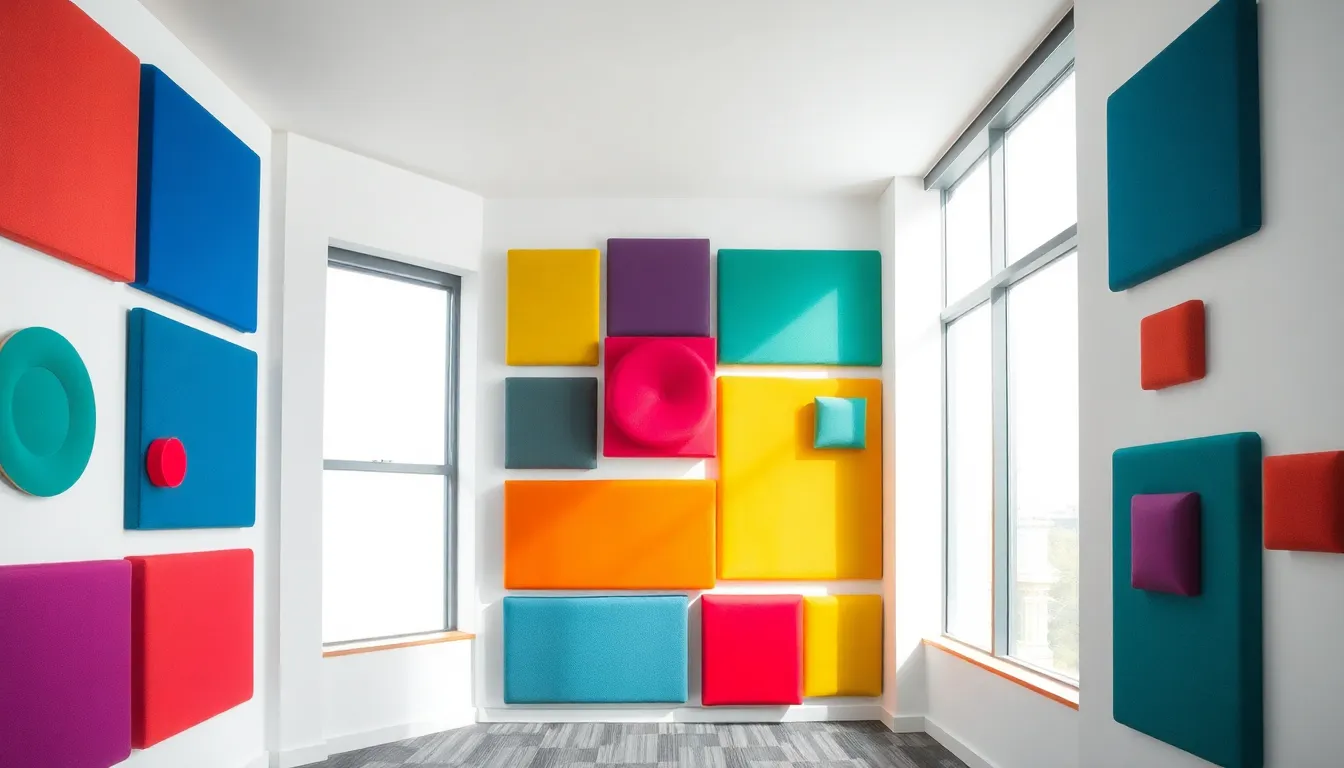Ever found yourself in a room where every sound echoes like a rock concert? If so, it’s time to say goodbye to that auditory chaos and welcome the soothing embrace of acoustic panels. These unsung heroes of soundproofing not only tame the noise but also add a touch of style to your space. Think of them as the cozy blankets for your walls, absorbing unwanted sounds while making your room look oh-so-chic.
Table of Contents
ToggleOverview of Acoustic Panel Installation
Acoustic panel installation involves several straightforward steps that enhance sound quality in various spaces. First, identifying the right location for panels is crucial; high-traffic areas and walls opposite sound sources often benefit the most. Second, selecting appropriate panel types caters to specific needs, with options ranging from fabric-wrapped to foam panels.
Measuring the wall space accurately ensures panels fit well and maximize sound absorption. It’s essential to mark where the panels will go, creating a clear layout on the wall. When it comes to the actual installation, using construction adhesive or mounting hardware accommodates different panel weights and sizes.
Aligning panels properly enhances the aesthetic while maintaining effective sound reduction. It’s important to start from a corner or the center of a wall, depending on the layout selected to achieve a balanced look. Once installed, checking for any gaps will help secure optimal performance.
Spacing panels to overlap slightly can improve sound absorption, particularly in larger rooms. Incorporating different panel sizes and shapes can create visually interesting designs while maintaining auditory benefits. Ensure adequate ventilation around installed panels for long-lasting durability.
Finally, monitoring the overall effect of the panels on sound quality will help in making adjustments or additions. Investing time in thoughtful installation enhances both the visual appeal and functionality of the acoustic treatment.
Benefits of Acoustic Panels

Acoustic panels provide notable advantages for any space, making them a practical choice for sound control and design.
Improved Sound Quality
Enhanced sound quality represents a primary benefit of acoustic panels. These panels effectively minimize echo and reduce background noise, creating a more pleasant auditory environment. When strategically placed, they absorb sound waves, leading to clearer conversations and improved audio experiences. Many users notice a significant difference in audio clarity within their rooms, whether in offices, studios, or homes. Investing in the right type and placement of these panels maximizes sound absorption, ensuring that echoes and reverberations decrease dramatically.
Aesthetic Enhancements
Aesthetic appeal also plays a significant role in the value of acoustic panels. These panels come in various colors, shapes, and sizes, allowing for creative and stylish design implementations. Designers often use panels to complement existing decor, create focal points, or even define zones within open spaces. It’s possible to achieve a sleek modern look with minimalist designs or opt for bold patterns that reflect personality. Incorporating these panels not only offers acoustic benefits but also elevates the visual interest of a room, contributing to an inviting atmosphere.
Types of Acoustic Panels
Acoustic panels come in various types and each serves specific sound absorption needs. Understanding these types helps in selecting the most suitable option for spaces requiring noise reduction.
Fabric Panels
Fabric panels consist of a sound-absorbing core wrapped in decorative fabric. They enhance both acoustic performance and aesthetics. These panels come in an array of colors and textures, enabling customization to fit any interior design. Their ability to reduce echo makes them popular in offices, studios, and homes. Installation involves straightforward mounting procedures, allowing for flexibility in arrangement.
Foam Panels
Foam panels are lightweight and often used in recording studios and home theaters. Made from open-cell polyurethane foam, they effectively absorb sound and minimize reflective noise. Available in various shapes and colors, foam panels can also add a visually appealing texture to walls. Installation is easy; adhesive backing or mounting hardware typically secures them in place. Their affordability makes them a favored choice for budget-conscious projects.
Wood Panels
Wood panels provide a natural look while maintaining sound absorption qualities. Crafted from sustainable materials, they combine aesthetic beauty with functionality. Wood panels help control reverberation and create a warm ambiance in spaces like restaurants and concert halls. Various finishes and designs enhance their versatility in different settings. Installation often involves direct mounting or use of a frame for added elegance.
Installation Process
Installing acoustic panels requires careful planning and attention to detail. Selecting the right tools and materials streamlines the process and enhances effectiveness.
Tools and Materials Needed
Gather essential tools and materials before beginning installation. You’ll need a measuring tape for accurately measuring wall space. A level ensures that panels align correctly, preventing uneven installation. Adhesive spray or mounting hardware facilitates secure attachment to the wall. Additionally, use a pencil for marking layout positions and a utility knife for trimming panels if necessary. Safety goggles protect the eyes during cutting tasks, while a ladder provides access to higher areas.
Step-by-Step Installation Guide
Start the installation by measuring the intended wall area for panel placement. After marking layout positions, align the first panel using a level to ensure accuracy. Apply adhesive or use mounting hardware to attach the panel securely. Continue this process, maintaining consistent spacing between panels for visual appeal and performance. Consider alternating sizes and shapes to enhance the aesthetic. Lastly, step back and assess alignment before making adjustments, ensuring each panel contributes effectively to sound absorption.
Maintenance and Care
Maintaining acoustic panels ensures optimal performance and longevity. Regularly inspecting panels for damage or wear helps identify any issues before they worsen. Dust accumulation can hinder performance, so cleaning panels frequently with a soft cloth or vacuum attachment is advisable.
Cleaning methods vary based on the panel type. For fabric panels, using a gentle upholstery cleaner or water-dampened cloth removes stains without risking fabric integrity. Foam panels might require a soft brush to dislodge dirt, while wood panels benefit from a wood-safe cleaner and occasional polishing.
Proper humidity levels in a room protect acoustic panels from moisture-related damage. Maintaining a relative humidity of 30% to 50% is ideal for preserving the integrity of foam and fabric materials. Checking and adjusting humidity levels with a dehumidifier or humidifier is recommended when needed.
Conducting assessments of the panels’ sound absorption effectiveness should occur periodically. This process can involve using sound level meters to evaluate noise fluctuations before and after installation. Adjustments to panel placement or additional panels might improve results when needed.
In environments exposed to high traffic or potential damage, such as studios or communal areas, implementing protective measures is beneficial. Utilizing corner guards or strategically placing furniture can prevent scuffs or impacts. These tactics preserve both aesthetics and functionality.
Monitoring color fading in brightly lit areas ensures the panels maintain their visual appeal. If color degradation occurs, consider repositioning panels from direct sunlight or using window treatments to manage light exposure. Regularly addressing these aspects keeps acoustic panels visually attractive and functional over time.
Installing acoustic panels can significantly enhance both sound quality and the overall aesthetic of any space. By carefully selecting the right type and placement of panels, individuals can create an environment that minimizes noise distractions while adding a stylish touch.
Regular maintenance and monitoring ensure these panels perform effectively over time. With the right tools and techniques, anyone can achieve a professional-looking installation that not only meets sound absorption needs but also complements their decor.
Investing in acoustic panels is a smart choice for those looking to transform their spaces into serene and visually appealing environments.


